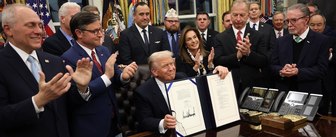Part of a series on YouGov survey methodology showing how we do our polling work and how to interpret our polling data.
Party affiliation influences Americans’ policy opinions, choices at the ballot box, and feelings toward members of other parties. Most American voters identify with one of the two major U.S. political parties – the Democratic or Republican Party – and YouGov uses a method to determine people's party identification that attempts to capture this relationship.
How we determine people’s party identification
When we ask respondents about the party with which they identify, we first ask whether they generally think of themselves as a Democrat, Republican, Independent, “not sure,” or “something else.” We allow the people who select “something else” to tell us their party identification via a text box. Anyone who selects Democrat or Republican is shown a second screen asking, “Would you call yourself a strong [Democrat/Republican] or a not very strong [Democrat/Republican]?”
If respondents instead select Independent, “something else,” or “not sure,” we typically classify them as Independents since they don't immediately identify with either of the major parties. We ask Independents whether they think of themselves as closer to the Democratic or Republican Party. In addition to saying they lean toward either party, these respondents can also say “neither” or “not sure.” (This series of questions, with a second question tailored to the response to the first on party identification—known as the Michigan party identification measure—is how many pollsters and academics have asked about partisanship for the past 70 years).
With this set of questions, YouGov can assign people to one of seven categories: strong Democrats, not very strong Democrats, Independents who are closer to — or lean toward — the Democratic Party, Independents who do not lean toward either party, Independents who lean Republican, not very strong Republicans, and strong Republicans. The leaners are the Independents who said they felt closer toward either party as partisan “leaners.” We then weight our data to ensure that our sample accurately reflects the distribution of party identification and other demographic characteristics in the U.S.
For our articles, we often group respondents using only the first party-identification question, which results in three categories: Democrats, Independents, and Republicans. Respondents classified as strong and not very strong Democrats in the seven-category scale are considered Democrats and strong and not very strong Republicans are considered Republicans. We classify Independents as Independents even if they lean toward a party. (Some other pollsters take a different approach by grouping the Independents who lean toward a party with people who identify with that party.) In Economist/YouGov surveys conducted since 2021, approximately 40% of respondents fall into the Independent category, with slightly more of the remaining 60% identifying as Democrats than as Republicans.
How do these groups vote in presidential elections?
Because party affiliation has such a significant impact on behavior, it is important to assess how the three-point and seven-point scales compare. Party is particularly influential on people’s choices at the ballot box.
In the 2020 and 2016 presidential elections, most strong Democrats (96% in 2020, 94% in 2016), not very strong Democrats (89% / 84%), and Independents who lean towards the Democrats (94% / 75%) on the seven-point scale voted for the Democratic candidate.
Similarly, majorities of strong Republicans (97% / 94%), not very strong Republicans (87% / 84%), and Independents who lean toward the Republicans (93% / 85%) on a seven-point scale voted for Donald Trump in the 2020 and 2016 presidential elections.
A slight majority of Independents who lean toward neither major party voted for Donald Trump in the 2020 (53%) and 2016 (54%) presidential elections, while a smaller proportion voted for Joe Biden in 2020 (39%) and Hillary Clinton in 2016 (24%). Independents were less likely to vote for a third-party candidate in 2020 (7%) than in 2016 (22%).
Presidential vote choice looks similar when using the three-category party identification scale. Most (94% / 92%) Democrats voted for Joe Biden and Hillary Clinton in 2020 and 2016. Similar proportions of Republicans (94% / 91%) voted for Donald Trump in the same years. Independents – including the ones who lean toward the Democratic or Republican party – were slightly more likely to vote for the Republican candidate in both years.
Approximately half (52% / 50%) voted for Donald Trump in 2020 and 2016, respectively. 43% voted for Joe Biden in 2020 and 33% voted for Hillary Clinton in 2016. Independents were more likely to vote for a third-party candidate in 2016 (18%) than in 2020 (5%).
Methodology: For the methodology, full data, and more details on The Economist/YouGov polls used, see past survey results.
Image: Adobe Stock (Andrii Yalanskyi)






